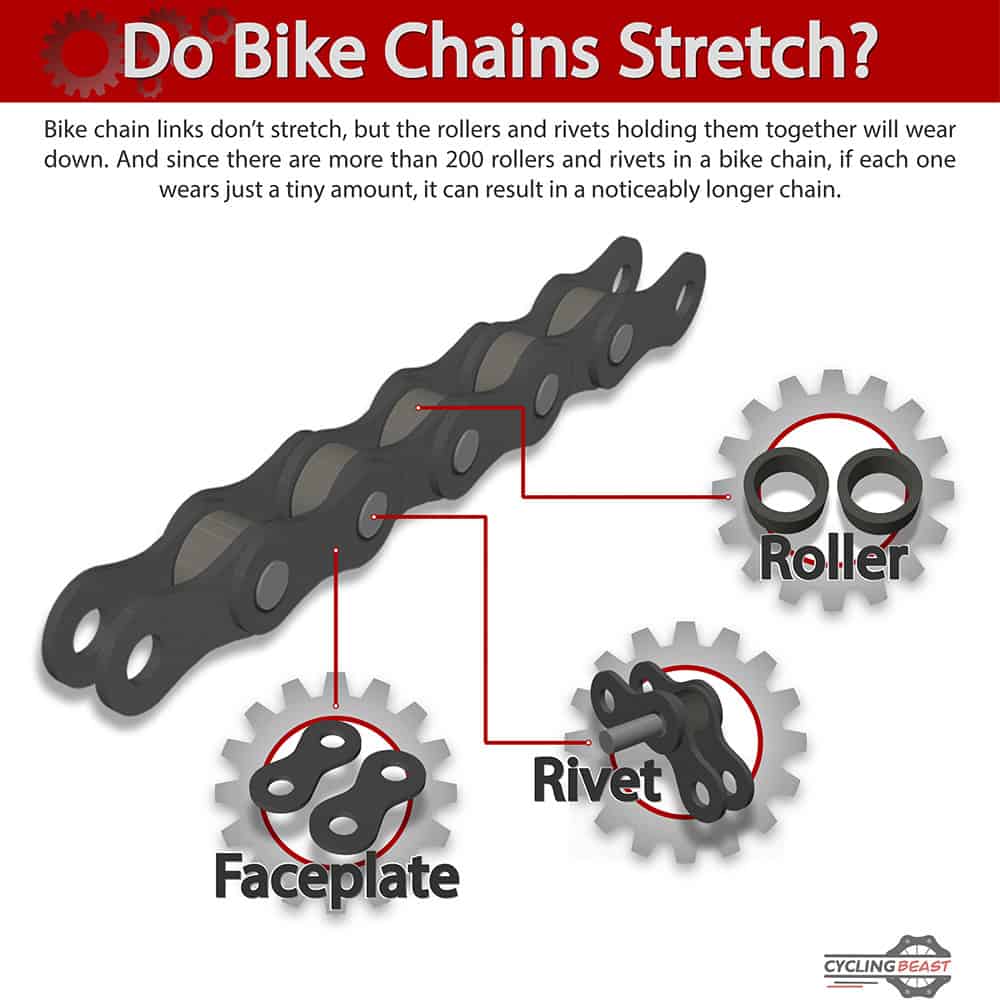Bike chains are made of strong metal links: so they couldn’t possibly stretch, right?
Actually, your bike chain will get measurably longer over time. While the links themselves don’t stretch, the rollers and rivets holding them together will wear down. Given that there are more than 200 rollers and rivets in a bike chain, if each one wears just a tiny amount, it can result in a noticeably longer chain.
How can you tell whether your chain has stretched or not? How much can your chain stretch before it should be replaced? And is it even safe to ride with a chain that has stretched?
That’s what we’ll cover right now.
Do Bike Chains Stretch (Technically)
A bike chain’s components are made out of steel. This makes them durable enough to withstand the stress placed on them while riding. You don’t have to be a metalworker to know something about steel: it’s not known for being elastic.
So technically no: though it’s often referred to as “chain stretch,” the components of a bike chain will not physically stretch out and become longer. But a chain will get longer over time if you put in a lot of miles.
How is this possible? If the chain’s components aren’t stretching out, how can it actually grow in length??
Do Bike Chains Stretch (Practically)
Those individual steel chain links are very strong, but in every system there are weak points. In the case of a bike chain, it’s the rivets connecting the links and the rollers that allow the links to pivot individually.
These components are also made of steel, but they just aren’t as durable as the links.

Over time, a chain’s rollers will wear out. A little bit of play will develop in between the links as the rollers’ usually tight tolerances begin to show signs of fatigue. As this occurs, miniscule gaps will appear between the roller and the link it sits within. Multiply this by the 200 or so rollers in every chain, and that “tiny” issue becomes a lot more pronounced.
A similar problem occurs at the rivet that slides between the rollers and holds the links together. Pedaling and shifting places a lot of linear force on your bike chain. This force attempts to pull the chain’s links apart, and over time the rivets will begin to bend in the center. If each rivet bends just a tiny bit, it gives the illusion the chain has grown measurably longer.
How to Tell if Your Chain is Stretched
Given that these miniscule increases in chain length typically don’t cause any perceptible damage to the chain’s appearance, a stretched bike chain won’t look much different from a brand new chain.

So how do you tell if your chain is stretched or not? Here are three methods:
Use a Chain Checker Tool
The most accurate way is to use a chain checker tool, like this one from Park Tool. Most chain wear gauges work similarly: with the hook end installed onto a chain link, the other end should not be able to fit in between a pair of links. If it does, the chain has stretched and may be in need of replacement.
The Park Tool Chain Checker is double-sided: one side indicates when your chain is worn 0.5% (your chain is 0.5% longer than when it was new) and the other side indicates when your chain is worn 0.75%.
Use a Ruler
Chain checker tools are pretty cheap, but if you don’t want to get one, you could use a ruler instead.
Place the 0 inch mark directly on one of the rivets connecting two chain links. Count 24 more rivets and the final rivet should land on the 12 inch mark (the rivets should be exactly ½ inch apart). If the last rivet is more than 1/16 inch beyond the 12 inch mark, your chain has stretched enough to warrant replacement.
1/16 inch doesn’t sound like much, does it? But even a slight stretch like this will have a noticeable negative impact on your shifting performance, and could be the precursor to internal damage or an impending chain break.
Lift Chain off Chainring
Shift your chain to the smallest cog on the cassette and to the largest chainring at the front (if you have more than one). Then, grab a link and attempt to lift the chain off the front chainring. If you can see a lot of space between the chain and the chainring, or can see the tips of the chainring’s teeth, your chain has stretched.
In this gearing configuration, the chain should be pulled tight against the chainring. If there’s a lot of wiggle room, the chain is longer than it was when it was new.
Keep in mind, this is the most subjective of the tests, but also requires no equipment, so you could go try it right now…if you have nothing better to do!
When to Replace Your Bike Chain
So how much stretch is acceptable, and how much is just too much?
This is where a chain checker tool (or ruler at the very least) becomes invaluable. The eyeball method may give you a rough idea of what’s going on, but can you tell the difference between a chain that’s stretched by 0.4% and one that’s stretched by 0.5%?
Me neither. And that 0.1% is the difference between a chain that’s good to go, and one that should be replaced.
If you use a chain checker tool, take into account the number of gears your bike has. If you have a 9-10-speed chain, it should be replaced when the 0.75% end fits inside the chain. For a 11-12-speed chain, it should be replaced when the 0.5% end fits inside the chain.
Why the difference? It has to do with overall chain length.
A 12-speed chain is longer than a 9-speed chain (to account for those bigger cogs on the drivetrain), so 0.75% chain growth is a larger amount on a 12-speed compared to a 9-speed chain. We now know tiny differences make a huge impact on shifting performance, so you’ll want to replace a longer chain at a smaller degree of chain growth.
If you’ve used a ruler, I mentioned above that the first and last of those 24 rivets measured should land on the 0 and 12 inch marks exactly. If the last rivet lands 1/16 inch past the 12, that’s your cue to replace it.
Again, 1/16 inch isn’t a lot, but we’re only measuring 12 chain links here…and your chain has more than 100. If every 12 links have grown in length by 1/16 inch, that will lead to some seriously poor shifting…assuming the chain can even stay on the cassette!
Like certain components on your bike (brake pads, tires, suspension oil, etc.) the chain is a consumable good: in the course of doing its job, it will eventually wear out and need to be replaced.
While there is certainly a cost to replacing a chain, it’s not astronomical (cheaper than a new tire for instance!) Compare the price of replacing a chain to that of buying a new cassette and chainring…which may be necessary if you keep riding on an old, stretched out chain that ruins your drivetrain.
Replacing your chain at the recommended time is an investment in a properly functioning bike, and will absolutely save you money in the long run. Which is great, because biking is expensive enough already!
